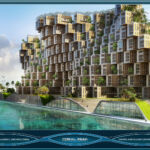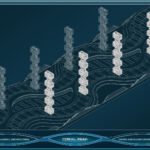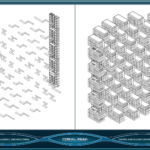Rebuilding Haiti: Coral Reef's Sustainable 1000 Passive Houses
Project's Summary
The Pearl of the West Indies, Haiti, was once a popular tourist destination in the Greater Antilles. However, in 2010, the country was devastated by a powerful earthquake, measuring 7.0 on the Richter scale. Now, Haiti is faced with the arduous task of rebuilding using innovative architectural and town-planning concepts.
One such project, called the Coral Reef, aims to construct a three-dimensional, energy self-sufficient village using standardized and prefabricated modules. These modules consist of two passive houses, made with a metallic structure and tropical wood facades, interconnected in a duplex formation. The units are linked by a horizontal circulation path, providing easy access to every dwelling.
Inspired by the fluid and organic shapes of a coral reef, the Coral Reef project is designed as a massive living structure, consisting of two undulating waves. This unique design can accommodate over one thousand Haitian families. The housing modules are arranged in staggered rows, allowing for cantilevered passive houses and a multitude of perspectives. The roofs of each module are transformed into suspended gardens, enabling Creole families to cultivate their own food and compost their waste.
The interior canyon between the two inhabited waves is a tropical ecosystem, supporting local fauna and flora. It serves as the central axis for communal life in this futuristic village, which prioritizes environmental sustainability. Public functions and social activities are integrated into the sinuous lines of the anti-seismic basement, while aquicultural farms and purification plant lagoons contribute to the overall sustainability of the village.
The master plan of the Coral Reef project is designed to evolve and expand according to the "plug-in" principle. Additional prefabricated modules can be added to meet the needs of the growing population. The architectural design incorporates bioclimatic systems and renewable energy sources. The pier's coverage utilizes sea thermal energy conversion, harnessing the temperature difference between superficial and deep waters. Hydro-turbines under the pier convert the kinetic energy from marine currents into electricity. Solar energy is captured through photovoltaic panels on the sinusoidal pergolas, and a park of spiral wind turbines is integrated into the tropical garden.
Haiti, with its natural and climatic advantages similar to its neighboring country, the Dominican Republic, has the potential to reinvent a sustainable urban environment. The Coral Reef project represents a positive and dynamic response to the urgent need for reconstruction in disaster-stricken areas. It aims to create high-quality, standardized, and industrialized social housing that is both humanitarian and environmentally friendly.
The Vincent Callebaut Architectures architectural studio has envisioned a future for Haiti that embraces sustainable development and meets the challenges of reconstruction head-on. By combining innovative design, renewable energy sources, and a commitment to environmental preservation, the Coral Reef project is a beacon of hope for a brighter future in Haiti.
Read also about the Ses Torres P5: Harmonious Modern Design in Natural Surroundings project






